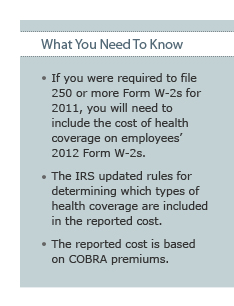Labor and Employment Alert: Update on Reporting the Cost of Health Coverage on Form W-2
The IRS issued Notice 2012-9 on January 3, 2012, clarifying some of its earlier guidance in Notice 2011-28 on reporting the cost of health coverage on Form W-2. The aggregate cost of health coverage will be reported in Box 12 with Code DD, starting with 2012 Form W-2s (distributed in January 2013). The reporting is informational and has no impact on the taxation of health coverage. This Client Alert summarizes the requirements as clarified.
guidance in Notice 2011-28 on reporting the cost of health coverage on Form W-2. The aggregate cost of health coverage will be reported in Box 12 with Code DD, starting with 2012 Form W-2s (distributed in January 2013). The reporting is informational and has no impact on the taxation of health coverage. This Client Alert summarizes the requirements as clarified.
Who has to report?
An employer that was required to file 250 or more Form W-2s for one year will need to report the cost of health coverage on employees' Form W-2s for the following year. Conversely, an employer that was required to file fewer than 250 Form W-2s for one year will not be required to report the cost of health coverage on employees' Form W-2s for the following year. For example, if your company was required to file fewer than 250 Form W-2s for 2011, you do not have to report the cost of health coverage on employees' 2012 Form W-2s. The exemption is intended to correspond to the exemption from electronic filing. Note that if you use an agent for Form W-2 reporting, you must count the number of Form W-2s you would have been required to file in the absence of an agent.
Third party sick pay providers do not need to report the cost of coverage. However, if the employer also provides a Form W-2 to an employee, the employer's Form W-2 should include the cost of coverage.
Whose coverage has to be reported?
If an individual isn't already entitled to a Form W-2 from your company, you don't have to generate one just to report the cost of health coverage. This means, for example, you do not have to report the cost of coverage for partners, individuals who retired or terminated employment in a prior year (who do not receive reportable compensation in the current year), or a former spouse on COBRA.
What coverage has to be reported?
The cost of coverage reported on Form W-2 generally includes medical and prescription drug coverage. As to other types of health coverage:
- Dental and vision. Dental and vision coverage is excluded from the reported cost if dental and vision coverage is separately insured or, if self-insured, subject to separate employee elections and contributions. Conversely, dental and vision coverage is included in the reported cost if self-insured and not subject to separate employee elections and contributions.
- FSAs. Employees' health flexible spending account (FSA) contributions are excluded from the reported cost. However, if the employer makes FSA contributions (or provides flex credits) so that the FSA exceeds the employee's salary reduction contributions, the excess is included in the reported cost.
- HRAs. Originally, health reimbursement arrangements (HRAs) would have been excluded from the reported cost. Under the recent clarifications, the IRS makes that an option. You now have the option to either include or exclude the value of an HRA from the reported cost.
- HSAs. Contributions to health savings accounts (HSAs) are excluded from the reported cost. HSA contributions have been and continue to be reported separately on Form W-2 in Box 12 with Code W.
- EAPs and on-site medical clinics. Originally, the reported cost would have had to include the value of employee assistance plans (EAP) and on-site medical clinics. Under the recent clarifications, the IRS makes that optional if (and only if) you don't charge a COBRA premium for EAP coverage or on-site medical clinic usage for COBRA qualified beneficiaries.
- Fixed indemnity insurance. Fixed indemnity insurance pays a fixed dollar amount in connection with a specified medical event (for example, $100 per day of hospitalization). Fixed indemnity insurance is excluded from the reported cost if (and only if) employees pay the entire premium on an after-tax basis. However, the entire cost of fixed indemnity insurance is included in the reported cost if employees pay any portion of the premium on a pre-tax basis and/or the employer pays any portion of the premium.
- Multiemployer plans. Taft-Hartley multiemployer plan coverage is excluded from the reported cost. Originally, the exclusion was mandatory but, under the recent clarifications, the IRS makes it optional. Since a contributing employer would not normally have the information needed to report the cost of multiemployer plan coverage, we expect that most contributing employers will exclude multiemployer plan coverage from their reporting.
What is the reportable cost?
The aggregate cost of coverage is based on your COBRA premiums (minus the 2% administration fee). Except for FSAs (as explained above), you do not need to distinguish between the share of the cost paid by the employer and the employee (pre-tax or post-tax). The reportable cost of coverage includes the value of coverage provided to domestic partners and domestic partners' children.
If an employee enrolls, drops, or changes health coverage mid-month, you may use any reasonable method for calculating the cost of coverage for the month. For example, if an employee changes from single to family coverage mid-month, you could use for the month: (a) the cost of single coverage; (b) the cost of family coverage; or (c) a proration of the cost of single and family coverage. You have to use the same method for all employees enrolled in the plan during the year.
For employees who terminate employment during the year, you may adopt a rule (applied consistently to all employees who terminate during the year) that either includes or excludes the cost of post-employment coverage. Thus, you have the option to include or exclude the value of COBRA coverage in the year an employee terminates.
If the employee requests his or her Form W-2 before the end of the year, you are not required to report the cost of health coverage on the employee's Form W-2.
If you calculate COBRA premiums on a 12-month period other than the calendar year, the reportable cost will change during the calendar year.
Future guidance on Form W-2 reporting
The IRS recognizes the system changes needed to implement Form W-2 changes. Future guidance will apply no sooner than the first calendar year starting at least six months after the guidance is issued.
As always, please contact us if you want more details or if you want to discuss how these Form W-2 requirements apply to your company.
In other news ... Still no clarity on essential health benefits
In our January 3, 2012 Client Alert, we described a Bulletin published by the Department of Health and Human Services (HHS) on how it intends to allow states to designate benchmark plans. The designated benchmark plans would set the standard for the essential health benefits that must be included in health insurance sold on state exchanges, at least for 2014 and 2015. HHS has now published an "Illustrative List" of the plans states might choose as their benchmarks plans (available at http://cciio.cms.gov/). However, neither the Bulletin or the List addresses the specific services that must be classified as essential for purposes of the prohibition on dollar limits on essential health benefits.
_______________________
IRS CIRCULAR 230 DISCLOSURE: In order to ensure compliance with requirements imposed by the U.S. Internal Revenue Service, we inform you that any federal tax information contained in this communication (including any attachments) is not intended or written to be used, and it cannot be used, by any taxpayer for the purpose of (i) avoiding penalties that may be imposed under the U.S. Internal Revenue Code; or (ii) promoting, marketing, or recommending to another person, any transaction or other matter addressed herein.
This client alert is for general information purposes and should not be regarded as legal advice.



